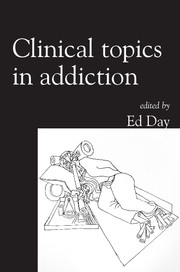Book contents
- Frontmatter
- Contents
- List of tables
- List of boxes
- List of figures
- List of contributors
- Foreword by Nat Wright
- Preface
- 1 What works in drug addiction?
- 2 The development of the drug treatment system in England
- 3 Stimulant use still going strong
- 4 Adverse effects of khat: a review
- 5 What the clinician needs to know about magic mushrooms
- 6 What works in alcohol use disorders?
- 7 Management of alcohol detoxification
- 8 Nicotine addiction and smoking cessation treatments
- 9 Pathological gambling: an overview of assessment and treatment
- 10 Use of investigations in the diagnosis and management of alcohol use disorders
- 11 Laboratory investigations for assessment and management of drug problems
- 12 Pharmacotherapy in dual diagnosis
- 13 Dual diagnosis: management within a psychosocial context
- 14 Treating depression complicated by substance misuse
- 15 Treating anxiety complicated by substance misuse
- 16 An overview of psychological interventions for addictive behaviours
- 17 Motivational interviewing
- 18 Substance misuse in adolescents
- 19 Management of drug misuse in pregnancy
- 20 Intoxication and legal defences
- 21 Substance misuse and violence: the scope and limitations of forensic psychiatry's role
- 22 Literary and biographical perspectives on substance use
- Index
3 - Stimulant use still going strong
Published online by Cambridge University Press: 02 January 2018
- Frontmatter
- Contents
- List of tables
- List of boxes
- List of figures
- List of contributors
- Foreword by Nat Wright
- Preface
- 1 What works in drug addiction?
- 2 The development of the drug treatment system in England
- 3 Stimulant use still going strong
- 4 Adverse effects of khat: a review
- 5 What the clinician needs to know about magic mushrooms
- 6 What works in alcohol use disorders?
- 7 Management of alcohol detoxification
- 8 Nicotine addiction and smoking cessation treatments
- 9 Pathological gambling: an overview of assessment and treatment
- 10 Use of investigations in the diagnosis and management of alcohol use disorders
- 11 Laboratory investigations for assessment and management of drug problems
- 12 Pharmacotherapy in dual diagnosis
- 13 Dual diagnosis: management within a psychosocial context
- 14 Treating depression complicated by substance misuse
- 15 Treating anxiety complicated by substance misuse
- 16 An overview of psychological interventions for addictive behaviours
- 17 Motivational interviewing
- 18 Substance misuse in adolescents
- 19 Management of drug misuse in pregnancy
- 20 Intoxication and legal defences
- 21 Substance misuse and violence: the scope and limitations of forensic psychiatry's role
- 22 Literary and biographical perspectives on substance use
- Index
Summary
Summary Amphetamines, cocaine and methylenedioxymethamphetamine (MDMA, ‘ecstasy’) are prominent on the UK drugs scene. Much cocaine is now in the form of ‘crack’, which produces particularly acute versions of well-known complications, including paranoid psychosis, mood disorders and cardiovascular problems. Ecstasy has additional hallucinogenic properties, and the slightly different range of psychiatric effects can be long-lasting. Assessment for stimulant misuse should include drug screening more than is currently common in general settings. Management comprises psychosocial (particularly behavioural counselling) and pharmacological approaches. A wide range of dopaminergic and other medications have been studied in cocaine misuse, and specialised substitute prescribing may be appropriate for heavy amphetamine injecting. There has been recent focus on problems of dual diagnosis, with particular strategies required to address stimulant misuse by people with severe mental illnesses.
In this chapter we revisit a subject that we reviewed almost a decade ago – the misuse of the most common illicit stimulant drugs (Seivewright & McMahon, 1996). In the drugs field, changes can certainly be expected in that length of time, particularly with substances linked to the so-called recreational drugs scene, where fashions and differences in usage come and go. Since the 1960s, when hallucinogens came into fashion, there has been prominence successively of barbiturates, pharmaceutical opioids and then smokable powdered heroin. In the decade leading up to our last review the widespread taking of methylenedioxymethamphetamine (MDMA, ‘ecstasy’) had emerged, and the long-established use of cocaine had increasingly transferred to its more potent ‘crack’ form. In 1996 we mainly considered four substances – amphetamine, powdered cocaine hydrochloride, crystalline ‘crack’ cocaine and MDMA – and since then all have remained highly prevalent on the drugs scene, with amphetamine and MDMA generally found in surveys to be the two most common drugs of misuse in the UK after cannabis.
Table 3.1 is an updated version of a table that appeared in our earlier review. It shows how the main stimulant drugs are used, approximate current street prices and their classification under the Misuse of Drugs Act 1971, which dictates the severity of penalties for supplying or possession.
- Type
- Chapter
- Information
- Clinical Topics in Addiction , pp. 29 - 41Publisher: Royal College of PsychiatristsPrint publication year: 2007



